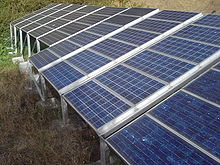
The photovoltaic effect is the generation of voltage and electric current in a material upon exposure to light. It is a physical phenomenon.[1]
The photovoltaic effect is closely related to the photoelectric effect. For both phenomena, light is absorbed, causing excitation of an electron or other charge carrier to a higher-energy state. The main distinction is that the term photoelectric effect is now usually used when the electron is ejected out of the material (usually into a vacuum) and photovoltaic effect used when the excited charge carrier is still contained within the material. In either case, an electric potential (or voltage) is produced by the separation of charges, and the light has to have a sufficient energy to overcome the potential barrier for excitation. The physical essence of the difference is usually that photoelectric emission separates the charges by ballistic conduction and photovoltaic emission separates them by diffusion, but some "hot carrier" photovoltaic devices concepts blur this distinction.
- ^ "Solar Cells - Chemistry Encyclopedia - structure, metal, equation, The pn Junction". www.chemistryexplained.com.